平成29年09月30日 土曜日号
“菊水 平成17年”
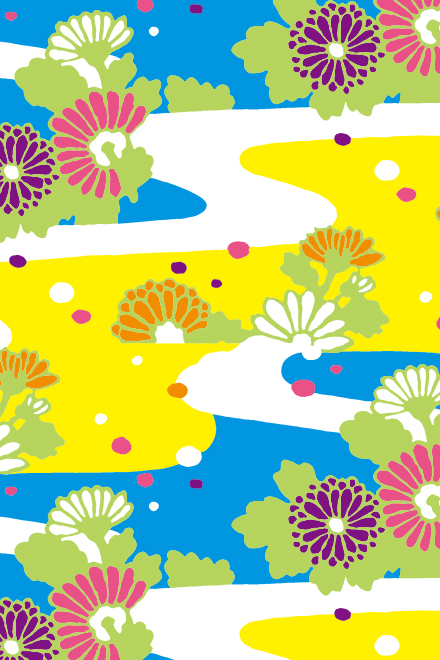
菊に水の流れという昔からある
日本の模様をシンプルに、
そして色を新しくして表現した。
昔からの模様にはいいものがいっぱいある。
それをどう生かしていくかが課題だ。
(脇阪 克二)
"Flowing chrysanthemum"(2005,by Katsuji Wakisaka)
Chrysanthemum with stream is a traditional pattern in Japan.
I painted it in a simple way but with new color arrangement.
There are numerous fantastic old pattern, into which we should inject new life.
| English translation by LI XIAO XIAO |
"Kikusui"(2005, par Katsuji Wakisaka)
J’ai simplifié et recoloré l’ancien motif japonisant
appelé kikusui, qui renvoie au courant de l’eau sur
les chrysanthèmes japonais.
Il existe de très nombreux jolis motifs d’antan.
La question est de savoir comment les transcender.
| Traduction française par Jean-Baptiste Fauvel Matsumoto |
"菊水"(2005, 胁阪 克二)
菊與流水古來有之。
我將這日本傳統紋樣調配新色,賦予它簡潔而嶄新的表現。
古文樣中有無窮的美,
如何發覺這些美,並喚起新生,
是我們現代人的使命。
| 中译 : 李 瀟瀟 |
→こちらのテキスタイルデザイン商品
(Textile products with this pattern)
平成29年09月28日 木曜日号
“茄子 平成27年”
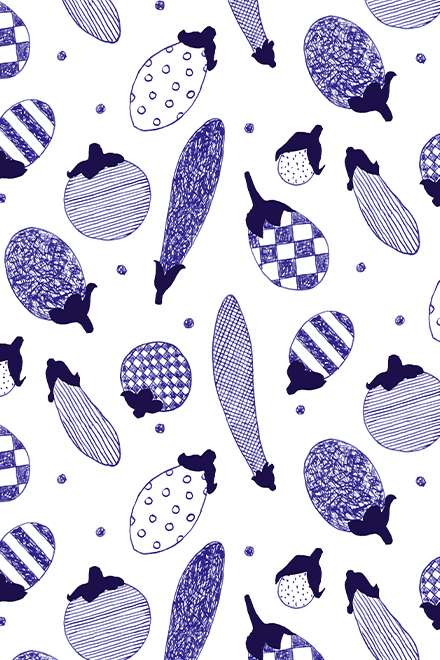
食物で何が好きかと問われれば
茄子と答える。
煮物もいいし田楽は最高。
ぬか漬けも好きだ。
茄子紺といわれる
少し紫がかった紺色も好きで
服は白か茄子紺を好んで着ている。
母も茄子が好きだった。
(脇阪 克二)
"Nasu / Eggplants"(2015,,by Katsuji Wakisaka)
"What is your favorite food?"
If I am asked, I will say "nasu (eggplants)"
They are good eaten stewed, and dengaku( grilled eggplants with sweet miso paste) are amazing.
I like nukazuke ( rice-bran pickles) too.
I like the color called "nasu-kon" which is purplish navy blue, and I often wear the colors nasu-kon or white by preference.
My mother also liked eggplants.
| English translation by Yuka Mamekoshi |
"Aubergine"(2015, par Katsuji Wakisaka)
S’il m’est demandé quelle serait ma nourriture préférée,
je répondrais les aubergines.
Marinées, elles sont délicieuses.
Grillées avec du miso, elles sont excellentes.
J’aime aussi quand elles sont marinées dans le vinaigre.
J’aime également les nasu-kon avec sa couleur violette,
que j’apprécie porter tout comme le blanc.
Ma mère aimait également les aubergines.
| Traduction française par Jean-Baptiste Fauvel Matsumoto |
"茄子"(2015, 胁阪 克二)
若被問起喜歡什麼食物,
我定會毫不猶豫回答,茄子。
清水煮好吃,田樂茄子更是絕品,
啊對了,醃製成漬物也不錯。
有種顏色叫『茄子紺』,是泛紫的藍色。
我就連平時愛穿的衣服顏色,也是除了白色就數茄子紺。
說起來我母親也很鍾愛茄子吶。
| 中译 : 李 瀟瀟 |
→こちらのテキスタイルデザイン商品
(Textile products with this pattern)
平成29年09月26日 火曜日号
“点字 平成29年”


目が見えない人のために
作られた点字。
平面から盛り上がった点の
並べ方によって 文字や数字を
表現したもので 指で触れていくことで
判読していく。
これは点字のそうそうを
使ってデザインしたもの。
(脇阪 克二)
"Braille "(2011,by Katsuji Wakisaka)
Braille is a system of raised dots that can be read with the fingers by people who are blind or who have low vision.
This textile design is made of “ SOU・SOU ” in braille.
| English translation by LI XIAO XIAO |
"Le braille"(2011, par Katsuji Wakisaka)
Le braille est un système d’écriture tactile à points saillants qui peut être lu par les malvoyants.
Ce design représente le terme “ SOU・SOU ” en braille.
| Traduction française par Jean-Baptiste Fauvel Matsumoto |
"紅點字(盲文)"(2011, 胁阪 克二)
為盲人發明的點字(盲文),
使用者通過觸摸平面上不同組合的凸點,
判讀識別其意義。
這幅織紋以點字中的SOU・SOU為素材而創作的。
| 中译 : 李 瀟瀟 |
→こちらのテキスタイルデザイン商品
(Textile products with this pattern)
平成29年09月25日 月曜日号
“赤とんぼ 平成23年”

暑さも少しおさまって秋風が吹き始めるころ、
思いがけず赤とんぼを目にすることがある。
なつかしいなぁ!
遊びまわっていたころの
ゆったりとした時間がよみがえってくる。
あのころに戻りたいとは思わないけれど、
二度と戻ってこない時は切なくいとおしい。
(脇阪 克二)
"Red dragonfly"(2011,by Katsuji Wakisaka)
Hot weather ends when autumn wind blowing.
Surprise! Here are some red dragonflies zipping around!
They remind me of my carefree childhood.
I don’t assuming that if I were a boy again,
But sometimes I sigh with deep emotion that how time flies .
| English translation by LI XIAO XIAO |
"Sympetrum / Libellule rouge "(2011, par Katsuji Wakisaka)
Alors que la chaleur laisse place au vent frais de l’automne,
on peut voir occasionnellement des libellules rouges.
Que de souvenirs!
Les heures passées à s’amuser refont surface.
Je n’aimerais pas revenir à cette époque mais,
le passé laisse une trace douloureusement nostalgique.
| Traduction française par Jean-Baptiste Fauvel Matsumoto |
"紅蜻蜓"(2011, 胁阪 克二)
暑熱減弱,秋風起。
在入秋的時節,意外地能見到一些紅蜻蜓。
這讓我想起兒時奔跑悠閒的時光。
也不是非要想回到那個時候,
只是為逝去的時光惋惜悵然。
| 中译 : 李 瀟瀟 |
→こちらのテキスタイルデザイン商品
(Textile products with this pattern)
平成29年09月23日 土曜日号
“月と星 平成14年”

満月の夜、半月や三日月の夜、
それぞれの趣があって美しい。
雲とたわむれながら闇とたわむれながら
月はめぐっていく。
星や月のやさしい光をあびながらゆっくり歩く。
(脇阪 克二)
"Moon and stars"(2002,by Katsuji Wakisaka)
Full moon, half moon, crescent moon.
Oh moon, showing different faces each and every night.
Oh moon, play with clouds and darkness, enjoying the night.
I took a walk under the moonlight, bathing in the light of moon and stars.
| English translation by LI XIAO XIAO |
"La lune et les étoiles"(2002, par Katsuji Wakisaka)
La pleine lune, la demi-lune, le croissant de lune.
Les unes aussi charmantes et belles que les autres.
Elle tourne incessamment sur elle-même
en jouant avec les nuages et l’obscurité.
Je marche paisiblement, sous la douce lumière de la lune et des étoiles.
| Traduction française par Jean-Baptiste Fauvel Matsumoto |
"月與星"(2002, 脇阪 克二)
月有不同表情
滿月,半月,新月
各有值得玩味的樣貌
月穿梭在雲中,與暗夜嬉戲,呈現出不同景象
我在月下,沐浴著星光和月光
漫漫散步。
| 中譯 : 李 瀟瀟 |
→こちらのテキスタイルデザイン商品
(Textile products with this pattern)
平成29年09月21日 木曜日号
“みたらし団子 平成23年”
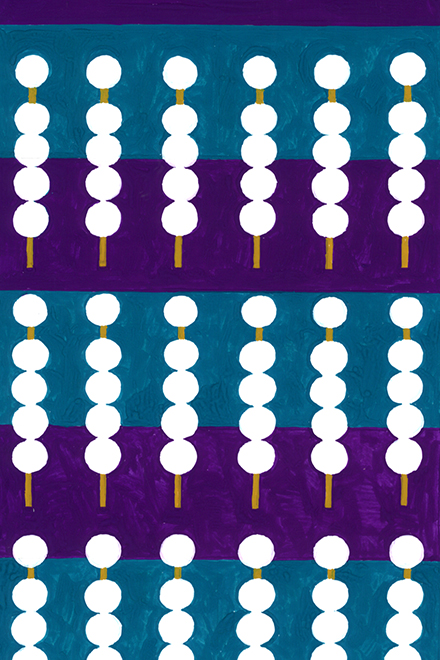
一年で月が最も美しい九月。
下鴨神社の名月管絃祭では、串にさされた
五個の真白な団子がお供えされる。
下鴨神社のみたらし池にブクブクと
浮かび上がってくる気泡を模して作られた団子が
みたらし団子の始まりだそうです。
(脇阪 克二)
" Mitarashi Dango / Glazed dumplings"(2011,by Katsuji Wakisaka)
September, the month when the moon appears most beautiful in Japan.
Meigetsu Kangensai Festival is taken place to adore the beautiful moonlight while enjoying the orchestra in the Shimogamo Shrine.
Five small round pure white mochi balls are are skewered on bamboo sticks and offered to shrine.
The name of Mitarashi Dango is said to come from the similarity between the mocha balls and the bubbles made by the purifying water (mitarashi) from the shrine’s entrance.
| English translation by LI XIAO XIAO |
"Mitarashi dango"(2011, par Katsuji Wakisaka)
Septembre, le mois où la lune est la plus belle au Japon.
Lors du festival Meigetsu Kangensai au Sanctuaire Shimoga,
5 dango blancs sont assortis sur une broche et offerts au sanctuaire.
Le nom de Mitarashi Dango serait né des similarités entre les boulettes
et les bulles faites par l’eau pure et sacrée à l’entrée du sanctuaire.
| Traduction française par Jean-Baptiste Fauvel Matsumoto |
"御手洗糰子"(2011, 胁阪 克二)
一年中最美的月出現在九月。
在每年下鴨神社舉行的明月管弦祭上,
五個潔白的小糯米糰子穿成一串,供奉神明。
據說這些圓圓的糰子,發想來自御手洗池波波波冒出的氣泡。
| 中译 : 李 瀟瀟 |
→こちらのテキスタイルデザイン商品
(Textile products with this pattern)
平成29年09月20日 水曜日号
“長閑 平成22年”
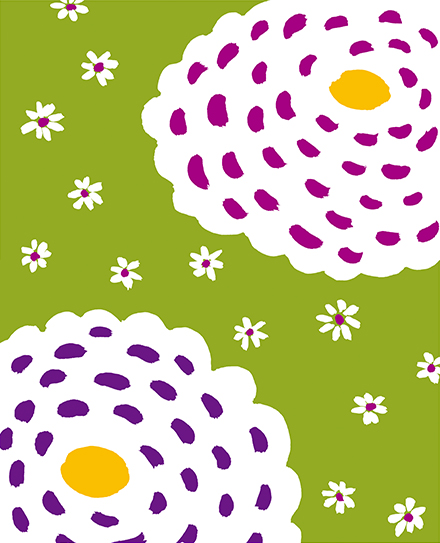
真白な大輪の菊は、たっぷりしていて、
見るものの気持ちも大らかになってくる。
植物は物言わないけれど、人間がつまらないことで
悩んでいることから救ってくれる。
のびのびと長閑な一日を送ろう。
(脇阪 克二)
"Tranquility "(2010,by Katsuji Wakisaka)
White chrysanthemum in large blossom,
Calm and relaxing.
Plants can’t speak,
But they weight off our mind from trifles,
Bringing us tranquility to enjoy a leisure holiday.
| English translation by LI XIAO XIAO |
"Tranquillité"(2010, par Katsuji Wakisaka)
Des chrysanthèmes aux larges pétales blancs,
calmes et relaxant.
Les plantes ne disent mots mais
elles libèrent les hommes de leurs petits traquas.
Quelle belle journée de tranquillité.
| Traduction française par Jean-Baptiste Fauvel Matsumoto |
"長閒"(2010, 脇阪 克二)
讓人心情療愈平和
植物雖然不會説話
但擁有無聲的力量將人從瑣碎的煩惱中拯救
悠然地度過閒適的一天
| 中譯 : 李 瀟瀟 |
→こちらのテキスタイルデザイン商品
(Textile products with this pattern)
平成29年09月09日 土曜日号
“怒濤 平成27年”
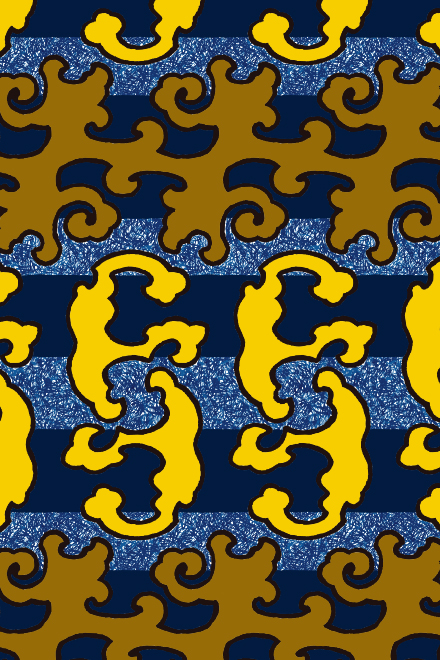
怒濤とは 荒れ狂う 大波、
激しく打ち寄せる波。
「怒濤のごとき快進撃」のように
圧倒的な勢いを表わす言葉として
使われることが多い。
(脇阪 克二)
"Doto / Angry waves"(2015,by Katsuji Wakisaka)
Doto, or angry waves, means swell or surging waves.
It’s a commonly used metaphor to describe overwhelming power.
For example, we can say,
“Great advice as unstoppable as angry waves”.
| English translation by LI XIAO XIAO |
"Doto / Bouleversement"(2015, par Katsuji Wakisaka)
Doto, traduit souvent par "bouleversement", fait référence
aux grandes vagues fortes s'écrasant contre les récifs.
Ce terme est souvent utilisé pour illustrer un fort élan,
comme dans l'expression:
"Un bon conseil, innarêtable comme une grande vague"
| Traduction française par Jean-Baptiste Fauvel Matsumoto |
"怒濤"(2015, 胁阪 克二)
怒濤,指氣勢雄偉的盛流,驚濤駭浪。
用來形容排山倒海的氣勢。
例如,
『怒濤般的大進軍』。
| 中译 : 李 瀟瀟 |
→こちらのテキスタイルデザイン商品
(Textile products with this pattern)
平成29年09月06日 水曜日号
“いろはごっこ 平成28年”
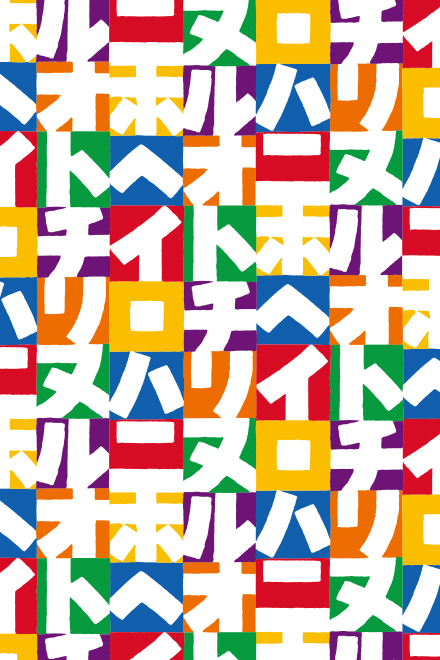
子供のいる家へ行くと
いろんなおもちゃがある。
箱の中に色とりどりのカタカナの
文字が入っている。
なつかしいなぁ!
子供時代がよみがえってくる
(脇阪 克二)
"Japanese character blocks"(2016,by Katsuji Wakisaka)
When I visit families with children,
Those interesting toys are attractive to me.
Colorful blocks of Japanese character (Katakana) in the box,
Bringing back my fun memories of childhood.
| English translation by LI XIAO XIAO |
"Iroha gokko / ABC"(2016, par Katsuji Wakisaka)
Il y a pléthore de jouets dans les maisons
où résident un enfant.
Il y a dans une boite des lettres coloroées
représentant l'alphabet japonais, les katakana.
Que de nostalgie!
Me revoilà dans ma plus tendre enfance.
| Traduction française par Jean-Baptiste Fauvel Matsumoto |
"假名游戲"(2016, 脇阪 克二)
去拜訪有小孩的朋友家
總會看到各種玩具
其中就有這種假名拼圖玩具
五彩繽紛的假名
整齊地裝在盒子裡
讓人懷念童年時光
| 中譯 : 李 瀟瀟 |
→こちらのテキスタイルデザイン商品
(Textile products with this pattern)
平成29年09月02日 土曜日号
“菊日和 平成29年”
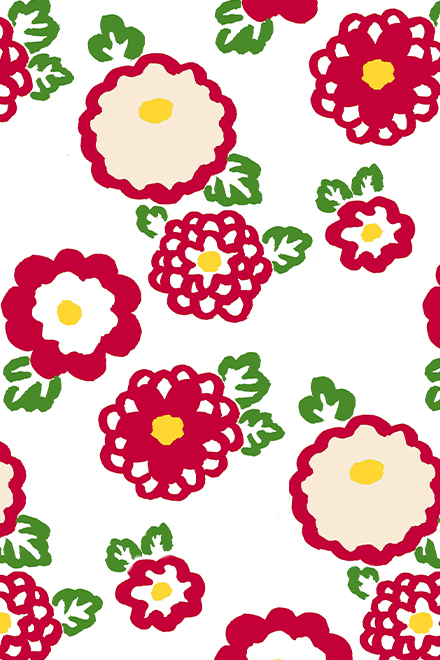
何の花と思って描いたわけでは
ないが やはり これは菊だろう。
何げなく 描いた時に出てくる
とらわれのない自由さが
この柄を生き生きとさせている。
秋のさわやかな菊日和のような一点。
(脇阪 克二)
"Fine day with chrysanthemum" (2017,by Katsuji Wakisaka)
I drew some flowers aimlessly.
I realized they are actually chrysanthemum only after I finished.
These aimless painted blossom,
With a natural freedom that makes the textile animated.
Just like a perfect autumn day for viewing chrysanthemum with clear air.
| English translation by LI XIAO XIAO |
"Belle journée d'automne"(2017, par Katsuji Wakisaka)
Je ne me suis pas demandé ce que je dessinais
mais il s'agit bien là d'un chrysanthème.
La liberté infinie née imperceptiblement de mon crayon
a donné naissance à ce motif.
Unique, comme une belle journée d'automne.
| Traduction française par Jean-Baptiste Fauvel Matsumoto |
"菊日和"(2017, 脇阪 克二)
菊日和(2017, 脇阪 克二)
我並沒有提前想好畫什麽花
隨意繪出幾朵,看起來應該是菊花吧
或許正是無心的描繪
賦予了這些菊花不被束縛的自由姿態
猶如秋天賞菊的好天氣一般神清氣爽
| 中譯 : 李 瀟瀟 |
→こちらのテキスタイルデザイン商品
(Textile products with this pattern)
平成29年08月26日 土曜日号
“何の花 平成29年”


昔の人は
絵と文や歌を組み合わせて
楽しんでいた。
てぬぐいにも 絵だけではなく
文字が 大事な要素に
なっているものがよくあった
僕も
何の花かわからない花と
文の組み合せに挑戦してみた。
(脇阪 克二)
"Whatnot flowers"(2017,by Katsuji Wakisaka)
People in ancient times enjoyed composing poems to consort with paintings.
Similarly, text is as important as textile patterns to tenugui towel.
I drew some whatnot flowers, and add some words, trying to make a harmonization.
| English translation by LI XIAO XIAO |
"Une fleur"(2017, par Katsuji Wakisaka)
Les japonais d'antan
s'amusaient à associer les dessins
avec des textes et des chants.
Il en est de même pour les tenugui,
où non seulement les dessins,
mais aussi les lettres sont devenues
des élèments importants.
Moi aussi
Je me suis posé comme challenge d'associer des mots
avec une fleur que je ne connais pas du tout.
| Traduction française par Jean-Baptiste Fauvel Matsumoto |
"不知名的花"(2017, 胁阪 克二)
古人結合繪畫,吟詩作歌,以此為雅興。
手巾上的織紋也是,文字與花紋同樣重要。
於此我也畫幾朵不知名的花,
書幾筆拙文,挑戰風雅。
| 中译 : 李 瀟瀟 |
→こちらのテキスタイルデザイン商品
(Textile products with this pattern)
平成29年08月16日 水曜日号
“水面 平成10年”

太陽の光をいっぱいに浴びて
水面がキラキラ輝いている。
流れに沿ってきらめきながら流れていく。
反射している光の波も刻々変化している。
ふと我にかえると先程とはまったく違った
たたずまいを見せて水は流れている。
(脇阪 克二)
"Water’s surface"(1998,by Katsuji Wakisaka)
Water gleams with kisses from the sun and
Ripples move in a forever flowing path.
Each wave, casts a reflection of sunlight, ever-changing.
When I came to myself,
The water’s surface shows a totally different appearance.
| English translation by LI XIAO XIAO |
"Surface de l'eau"(1998, par Katsuji Wakisaka)
L'eau scintillent de milles feux
grâce aux rayons du soleil.
Suivant le courant, elle coule en brillant.
Les vagues de lumière changent sans cesse.
En reprenant mes esprits, je me rends compte que
l'eau me montre un aspect totalement différent de son courant.
| Traduction française par Jean-Baptiste Fauvel Matsumoto |
"水面"(1998, 胁阪 克二)
陽光灑在水面,
閃閃銀河流動。
反射的光亮星星點點,
匯成變幻莫測的流動波紋。
我回過神來,
水流呈現出與先前完全不同的模樣。
| 中译 : 李 瀟瀟 |
→こちらのテキスタイルデザイン商品
(Textile products with this pattern)
平成29年08月12日 土曜日号
“トマト 平成27年”
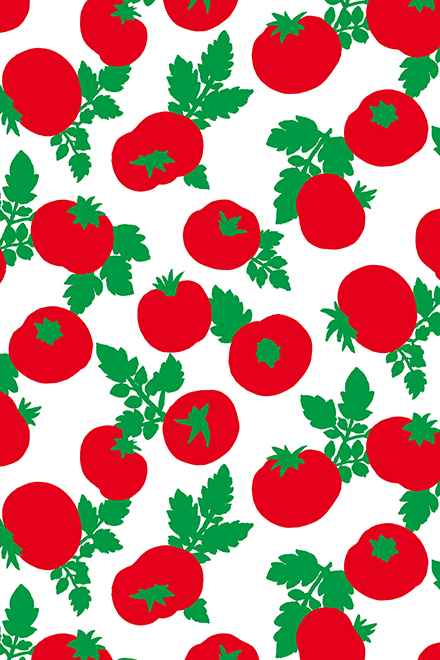
まっ赤なトマト。
丸いトマト。
かわいいトマト。
元気なトマト。
甘くすっぱいトマト。
(脇阪 克二)
"Tomato"(2015,by Katsuji Wakisaka)
A bright red tomato.
A round tomato.
A cute tomato.
A tomato full of vitality.
A sweet-and-sour tomato.
| English translation by LI XIAO XIAO |
"Tomate"(2015, par Katsuji Wakisaka)
Une tomate toute rouge.
Une tomate ronde.
Une jolie tomate.
Une tomate pleine de vie.
Une tomate douce-amer.
| Traduction française par Jean-Baptiste Fauvel Matsumoto |
"番茄"(2015, 胁阪 克二)
紅通通的番茄。
圓溜溜的番茄。
可愛的番茄。
生氣勃勃的番茄
甜甜酸酸的番茄。
| 中译 : 李 瀟瀟 |
→こちらのテキスタイルデザイン商品
(Textile products with this pattern)
平成29年08月09日 水曜日号
“青海波 平成24年”
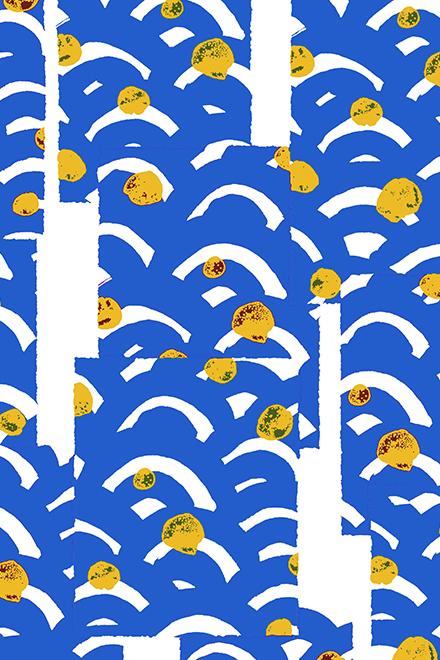
ゆったりとした波おだやかな青い海は
平和な日常を連想させる。
そのため青海波はおめでたい文様として
季節にかかわりなく使われる様になった。
日本的な文様だと思っていたが
ペルシャ、ササン朝様式に端を発したものだそう。
(脇阪 克二)
"Blue waves"(2012,by Katsuji Wakisaka)
The calm blue sea,
Gentle lapping of the waves,
People always associate that with a quiet life.
Seikaiha, or the blue sea waves, one of the most popular decorative patterns in Japan.
It is said that it was developed in Sassanian Persia,
While I found a Japanese sense in this pattern.
| English translation by LI XIAO XIAO |
"Seigaiha"(2012, par Katsuji Wakisaka)
Les vagues calmes et le ciel bleu tranquille
Nous rappellent le quotidien paisible.
C’est pourquoi le motif à vagues bleues est associé
aux festivités, peu importe la saison.
Je pensais qu’il s’agissait d’un motif typiquement japonais mais
Il semblerait qu’il soit apparu en Perse, via les Sassanides.
| Traduction française par Jean-Baptiste Fauvel Matsumoto |
"青海波"(2012, 胁阪 克二)
緩緩的碧波,輕柔的海,
讓人聯想到平和的日常生活。
也許正是因為這樣,青海波才被視為與季節無關的,吉祥寓意的傳統紋樣。
我也覺得這個波瀾不驚的織紋溫雅而日式。
據說青海波最早是源於波斯王朝。
| 中译 : 李 瀟瀟 |
→こちらのテキスタイルデザイン商品
(Textile products with this pattern)
平成29年08月05日 土曜日号
“朝顔すだれ 平成20年”
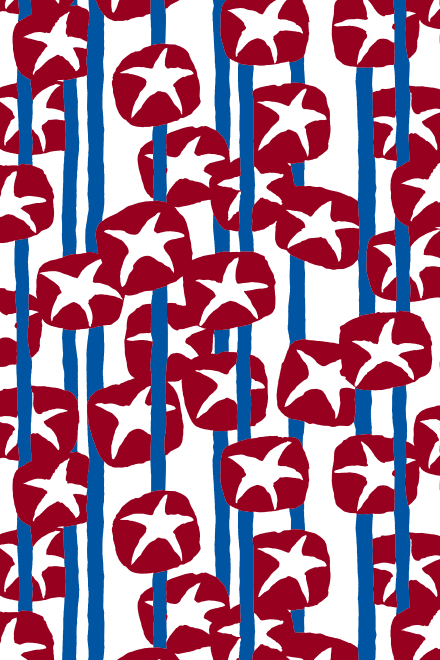
朝顔は幼いとき、夏になると身近にいっぱい咲いていた。
よく知っているとそのイメージに
ひきずられてつまらなくなってしまう。
思い切って単純化し、
丸い朝顔を四角っぽくしてみると
かわいくなったと思う。
(脇阪 克二)
"Morning glory and bamboo screen"(1996,by Katsuji Wakisaka)
As a summer memory of my childhood,
Morning glory burst around,
Every year and everywhere.
I simplify those flowers thoroughly,
Illustrating the round faces into square shapes.
That gives morning glory a fresh sense.
| English translation by LI XIAO XIAO |
"Liseron japonais "(1996, par Katsuji Wakisaka)
Lorsqu’il est jeune, le liseron japonais donne beaucoup de fleurs en été.
Quand vous le savez, cette image reste ancrée en vous.
Si vous le simplifiez intrinsèquement,
En donnant une forme carré à ses fleurs rondes,
Je trouve que cela devient déjà beaucoup plus mignon.
| Traduction française par Jean-Baptiste Fauvel Matsumoto |
"牽牛花竹簾"(2010, 胁阪 克二)
兒時每到夏天附近就開滿了牽牛花。
周而復始也就不覺得新鮮好看了。
我盡可能將牽牛花簡化,
把它圓圓的輪廓故意畫成方形,
記憶中索然無味的朝顏突然變得俏皮可愛起來。
| 中译 : 李 瀟瀟 |
→こちらのテキスタイルデザイン商品
(Textile products with this pattern)
平成29年08月02日 水曜日号
“木芙蓉 平成29年”
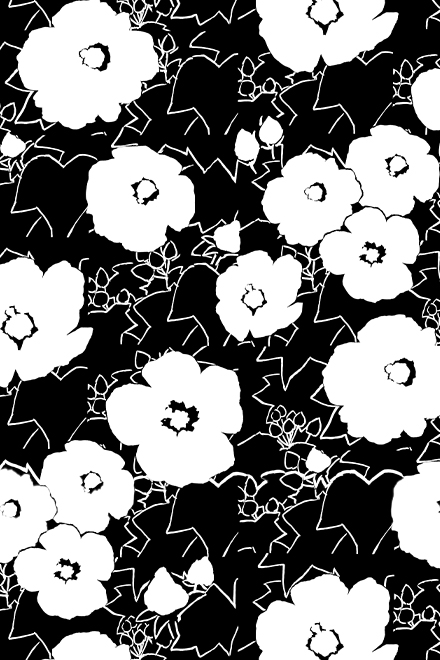
夏から秋にかけて咲く芙蓉。
朝、白かピンクの大輪の花を
咲かせ夕方にはしぼんでいく。
一日でしぼむので
儚い花を思い浮かべるかも
しれないが
どんどん蕾が開き花を咲かせる
ので強い生命力を感じる。
花の少ない暑い季節に
元気を与えてくれる。
(脇阪 克二)
"Lotus"(2017,by Katsuji Wakisaka)
Lotus blooms between summer and autumn.
Big flowers in white or pink,
They burst in the morning and fade at dusk.
The flowers last only for one day.
You may sigh for it's ephemeral,
But look!
Buds opens one after another,
Showing great vitality.
Very few flowers bloom in this muggy season,
These lotus cheers me up.
| English translation by LI XIAO XIAO |
"Lotus"(2017, par Katsuji Wakisaka)
Lotus fleurit entre l’été et l’automne.
Le matin, il ouvre ses grands pétales blancs
Et le soir venu, il les referme délicatement.
Comme il se fane en une seule journée,
Le lotus a peut être une image de fleur éphémère
Mais on ressent une forte vitalité à la vue de son
Bourgeon qui laisse place à une magnifique fleur.
En cette période estivale peu fleurie,
Le lotus nous donne de l’énergie.
| Traduction française par Jean-Baptiste Fauvel Matsumoto |
"芙蓉"(2017, 胁阪 克二)
芙蓉開在夏秋交替的時節,
清晨,開出白色或粉色的花,一大朵。
傍晚就枯萎凋零。
也別看它是稍縱即逝的,
那些蓓蕾接連綻放,
相擁無數短暫的生命,
簇成一股強大的生命力。
在這個花開不多的暑熱時節,
給我勇氣,給我力量。
| 中译 : 李 瀟瀟 |
→こちらのテキスタイルデザイン商品
(Textile products with this pattern)
平成29年07月29日 土曜日号
“高瀬 平成20年”
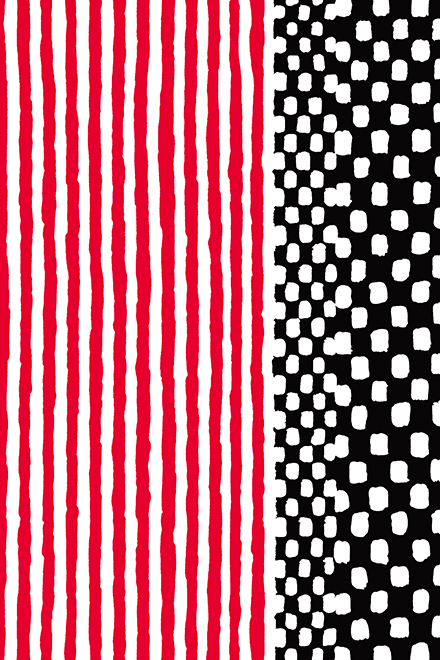
川の瀬の浅い所へ来ると、
底の石や砂が顔を出してサラサラと音を立てる。
四角と縞の模様だが
川が流れている情景が浮かんでくる。
(脇阪 克二)
"The takase river"(2008,by Katsuji Wakisaka)
Come to the shallow part of the river,
I saw sandstones on the bottom emerged,
Making murmuring sound.
I just use small squares and stripes to perform this scene.
| English translation by LI XIAO XIAO |
"Haut-fond"(2008, par Katsuji Wakisaka)
En se rendant aux petits ruisseaux peu profonds,
On peut voir les galets et le sable pointés leur nez, tout en bruissant.
Il s’agit ici de motifs carré et à rayures mais
Il ne sont pas sans rappeler les courts d’eau en mouvement.
| Traduction française par Jean-Baptiste Fauvel Matsumoto |
"高瀨川"(2008, 胁阪 克二)
目光投向水淺的地方,
河底的砂石探出頭來,
與流水擦肩,潺潺淙淙。
我用簡單的小方塊和線條的紋樣,
再現這般清淺溪流的景象。
| 中译 : 李 瀟瀟 |
→こちらのテキスタイルデザイン商品
(Textile products with this pattern)
平成29年07月25日 火曜日号
“万葉集 平成29年”


万葉集は 7~8世紀にかけて
編集された日本最古の和歌集。
天皇、貴族から 下級官人、防人など
さまざまな 身分の人が詠んだ歌
4500首以上を集めたもの。
長い歳月を超えて
昔の人々の おおらかで 率直な
生き方や感じ方に 魅せられ
夢やロマンを かきたてられる。
(脇阪 克二)
"Man’yoshu poetry"(1996,by Katsuji Wakisaka)
The Man’yoshu, literally "Collection of Ten Thousand Leaves",
Is the oldest existing collection of Japanese poetry, compiled from 7th century to the 8th.
It includes about 4,500 waka poems composed by different social classes.
The Man’yo poetry is beautiful and vivid,
Leisurely lifestyle, romantic feelings and poetic touch in days of old were expressed in these poems.
| English translation by LI XIAO XIAO |
"Man’yōshū"(1996, par Katsuji Wakisaka)
Le Man’yōshū est le plus ancient receuil de poésie japonaise traditionnelle,
Appelée waka, composé entre le 7ème et le 8ème siècle.
Plus de 4500 poèmes y comptent les aventures de gens de différents rangs,
De l’empereur à la bourgeoisie, en passant par les fonctionnaires et les soldats.
Dépassant le temps et les générations,
Les rêves et les romances des gens de l’époque y sont racontés,
Tout en dépeignant les façons de vivre et de percevoir les choses
De manière très généreuse, franche et directe.
| Traduction française par Jean-Baptiste Fauvel Matsumoto |
"萬葉集"(2010, 胁阪 克二)
萬葉集編撰於7-8世紀,是日本最古的和歌集。
上到天皇,貴族,下至朝臣,民眾,
集聚了身份各異的人詠誦的4500首以上的和歌。
古時候人們率性本真的生活態度和纖細的感受性,
經過漫長歲月的沖刷洗練,
綻放著夢幻而浪漫的光華。
| 中译 : 李 瀟瀟 |
→こちらのテキスタイルデザイン商品
(Textile products with this pattern)
平成29年07月21日 金曜日号
“水音(みなおと) 平成21年”
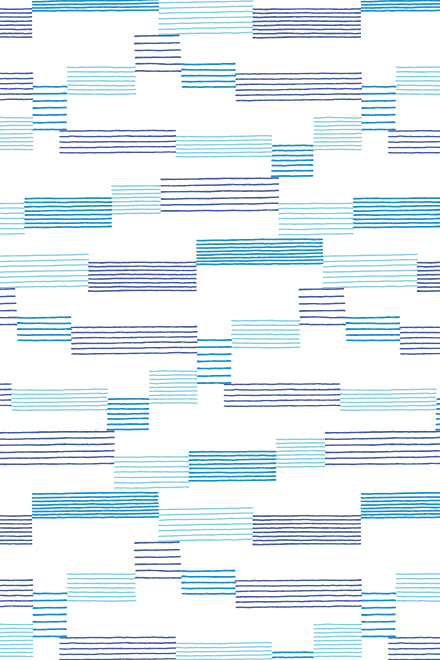
京の夏は暑い。さまざまな線で
水が流れる音を表してみた。
山の湧き水、川のせせらぎ…。
見る人によってイメージすることは
いろいろあると思うが、
少しでも涼を感じてもらえればうれしい。
(脇阪 克二)
"Sound of water in summer"(2009,by Katsuji Wakisaka)
Summer in Kyoto is boiling hot.
I drew various lines to express different sound of running water.
Such as bubbling of spring water or murmuring of a stream.
Image of these lines differs from person to person,
Anyhow I hope to share a cool feeling with you through this textile design.
| English translation by LI XIAO XIAO |
"Son de l’eau"(2009, par Katsuji Wakisaka)
L’été dans l’ancienne capitale est caniculaire.
J’ai représenté le son de l’eau des différents canaux de la ville.
Les sources de montagnes, les petits ruisseaux…
L’image dont on se fait de ces sons est différente selon les personnes.
J’espère toutefois vous apporter un petit vent de fraîcheur.
| Traduction française par Jean-Baptiste Fauvel Matsumoto |
"水音"(2009, 胁阪 克二)
京都夏日酷熱。
我用各種線條表現流水的聲音。
有從山里湧出的咕嘟聲,也有小溪的潺潺聲……
這幅織紋不同人看聽到的水聲也不同吧,
只願多少能夠給你帶來一絲清爽涼意。
| 中譯 : 李 瀟瀟 |
→こちらのテキスタイルデザイン商品
(Textile products with this pattern)
平成29年07月15日 土曜日号
“金魚すくい 平成23年”
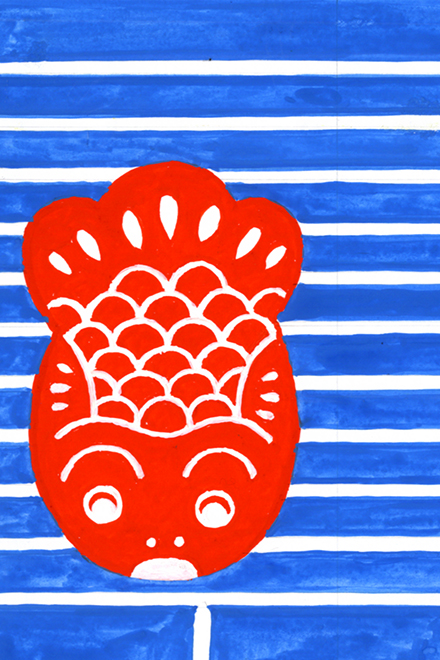
子供のころ楽しかった思い出のひとつにお祭りがある。
みこしが来るお旅所の広場に屋台がいっぱい並んで
おおぜいの人でにぎわっていた。
輪投げ、スマートボール、
鼈甲(べっこう)飴、お好み焼きなど、わくわくするものがいっぱいあった。
金魚すくいは下手だったが
お祭りにはなくてはならないものだった。
(脇阪 克二)
"Goldfish catching"(2013,,by Katsuji Wakisaka)
Summer festival is one of the best memories of my childhood.
A number of food stalls lines up near by the mikoshi (decorative floats),
Streets were lively with people.
Quoits game, smart-ball (form of pinball), bekkoame candy and okonomiyaki are my favorites.
Goldfish catching is also an essential entertainment during the festival,
However, I’m not good at that…
| English translation by LI XIAO XIAO |
"Pêche au poisson rouge à l’épuisette"(2013,, par Katsuji Wakisaka)
Dans mes bons souvenirs d’enfance, on y trouve les fêtes d’été, appelées matsuri.
Sur la place où est déposé le sanctuaire, de nombreux stands sont montés,
Remplissants les rues de gens et de vies.
Fer à cheval, bagatelle, confiseries, Okomiyaki (galette de chou sucrée-salée),
Toute une ribambelle de petits plaisirs enthousiasmants.
Je n’étais pas doué pour la pêche au poisson rouge à l’épuisette mais
Elle faisait partie des attractions indispensables aux fêtes d’été.
| Traduction française par Jean-Baptiste Fauvel Matsumoto |
"撈金魚"(2013,, 胁阪 克二)
兒時記憶裡的夏日祭總是充滿歡樂。
在山車附近的空地上排滿了攤販,人潮洶湧,熱鬧無比。
套圈圈,彈珠台,
玳瑁糖,御好燒…夜市裡充滿了我的美好回憶。
撈金魚也是必不可少的夏日祭主角,雖然我並不太擅長……
| 中译 : 李 瀟瀟 |
→こちらのテキスタイルデザイン商品
(Textile products with this pattern)






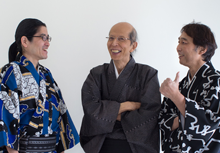

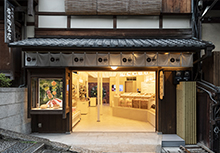

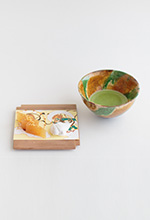
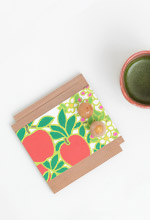
 お問い合わせ窓口
お問い合わせ窓口